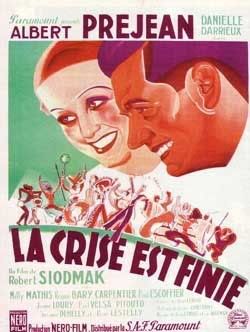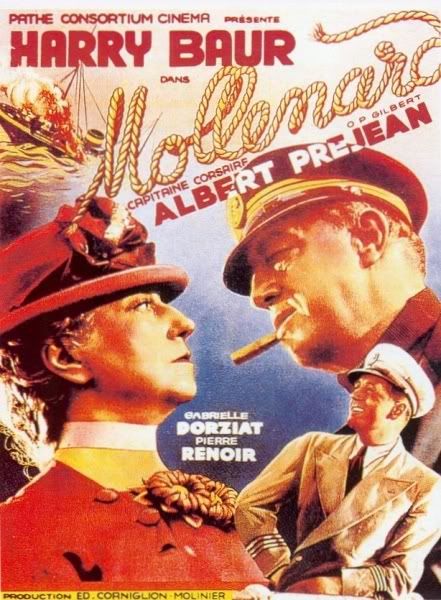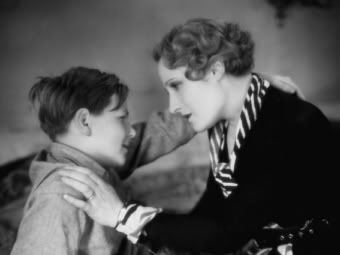Hi Anne,
Please let me reassure you that the underlying themes that Moxie described are subtly suggested and are not overt. You can watch this film as a mystery and character sketch. Plus, it has someone we forgot to mention in the cast whose slightly tawdry presence insures a good time: Gladys George.
Ms. George plays the proprietess of Maison LaFitte, the not so gilded cage where Deanna warbles soulfully after Gene Kelly goes up the river to visit the gray bar hotel. Gladys seems to be playing a slightly older and wiser New Orleans version of the Texas Guinan type she brought to life in The Roaring Twenties (1929). Even though she isn't given much to do, any time Gladys George shows up in a movie, I'm delighted to see her. Though I know that you're not a fan of Gene Kelly, it is also fun to see him trying his cinematic wings here.
Robert Siodmak Films
- moira finnie
- Administrator
- Posts: 8024
- Joined: April 9th, 2007, 6:34 pm
- Location: Earth
- Contact:
- moira finnie
- Administrator
- Posts: 8024
- Joined: April 9th, 2007, 6:34 pm
- Location: Earth
- Contact:
I started to discuss my abiding interest in director Robert Siodmak today with a couple of posters over on the TCM board, and thought that it might be of interest to a few members here too, especially since we have some very knowledgeable film noir aficionados among our posters. I know that lots of people know much more about film noir and Siodmak's films than I do, but hope that revival of this thread is a jumping off point for further discussion, (and my continuing education!)

In a scene when Ella Raines visits Alan Curtis in prison in Phantom Lady (1944), characteristically dramatic lighting, so typical of a Siodmak film. It may have been done in part to save money on sets, but also to visualize the psychological mood of the film.
My respect for the blend of expressionistic and realistic elements in the movies directed by Robert Siodmak deepens with every film I see by this director. Though best known to today's audiences for Phantom Lady (1944), The Spiral Staircase (1945), The Killers (1946), and Criss Cross (1949), his less well known movies deserve to be seen, especially those that are not on dvd. One example of Siodmak's less accessible films is The Great Sinner(1949), an interesting if flawed attempt to adapt Dostoyevsky to the screen that was thankfully recently broadcast on TCM once again.
Siodmak's other, more dramatically successful films are the memorable noirs Cry of the City (1948), The Dark Mirror (1946), The File on Thelma Jordon (1950), (being broadcast again on TCM on Apr 13, at 10:00AM ET), one of my favorite George Sanders films, The Strange Affair of Uncle Harry (1945), the brilliant The Suspect (1944), and the flawed but intriguing Christmas Holiday (1944). I realize that some of these films, (such as Cry of the City), do show up once in a blue moon on cable (FMC), but many of the films mentioned above are never seen anymore, though their quality is unforgettable.
Has anyone ever seen People on Sunday aka Menschen am Sonntag (1929)? This is the documentary that launched the careers of co-directors Robert Siodmak and Edgar Ulmer, and co-screenwriters Billy Wilder and Curt Siodmak (Robert's younger brother), cinematographer Eugen Schufftan and his assistant, Fred Zinnemann. This film is apparently available on a Region 2 dvd, but is not available in North America.
Has anyone ever seen the films made by Siodmak in France?
Thanks for any insights !
Reasons for Siodmak's appeal to me:
I find many of his films have a darkly romantic quality, and are not cold in the least. This visually powerful romanticism comes through in films in which the director had opportunities to work with such imaginative cinematographers as Paul Ivano (The Suspect & The Strange Affair of Uncle Harry), Nicholas Musuraca, (The Spiral Staircase), and Elwood Bredell (Phantom Lady, Christmas Holiday & The Killers). When working with these fine craftsmen, the director makes the environment where the characters dwell another, often ominous, sometimes comforting character.
Another appealing aspect of his films is that he tends to give performers who've rarely had a chance to shine an opportunity.

Ella Raines, a now seemingly forgotten actress, was an intelligent beauty who attracted the professional attention of protean directors such as Howard Hawks, Preston Sturges, and John Sturges. She may never have been better than she was in Siodmak's movies, and she appeared in four, Phantom Lady (1944),The Suspect(1944) The Strange Affair of Uncle Harry (1945) and Time Out of Mind (1947).
In The Dark Mirror, an actor probably best known today for some pretty insipid tv shows, Richard Long gave an excellent performance in a very brief role as did all the leading actors, (Olivia de Havilland, Lew Ayres & the wonderful Thomas Mitchell). Elisha Cook, Jr. in a flashy part as a jazz drummer in Phantom Lady has one of his best, (and loopiest) parts. In The Strange Affair of Uncle Harry (1945), Siodmak shone a spotlight on the under-utilized talents of George Sanders and Geraldine Fitzgerald. in a daring, (and censored) film. Siodmak also helped performers such William Conrad & Charles McGraw in The Killers, (see below), who'd never had much opportunity on screen, to begin promising careers as character actors.

I wonder if this director's reputation has suffered because many of his films are no longer broadcast nor on dvd and, as some believe, his best work has been confined primarily to one style of filmmaking rather than a variety of genres?

In a scene when Ella Raines visits Alan Curtis in prison in Phantom Lady (1944), characteristically dramatic lighting, so typical of a Siodmak film. It may have been done in part to save money on sets, but also to visualize the psychological mood of the film.
My respect for the blend of expressionistic and realistic elements in the movies directed by Robert Siodmak deepens with every film I see by this director. Though best known to today's audiences for Phantom Lady (1944), The Spiral Staircase (1945), The Killers (1946), and Criss Cross (1949), his less well known movies deserve to be seen, especially those that are not on dvd. One example of Siodmak's less accessible films is The Great Sinner(1949), an interesting if flawed attempt to adapt Dostoyevsky to the screen that was thankfully recently broadcast on TCM once again.
Siodmak's other, more dramatically successful films are the memorable noirs Cry of the City (1948), The Dark Mirror (1946), The File on Thelma Jordon (1950), (being broadcast again on TCM on Apr 13, at 10:00AM ET), one of my favorite George Sanders films, The Strange Affair of Uncle Harry (1945), the brilliant The Suspect (1944), and the flawed but intriguing Christmas Holiday (1944). I realize that some of these films, (such as Cry of the City), do show up once in a blue moon on cable (FMC), but many of the films mentioned above are never seen anymore, though their quality is unforgettable.
Has anyone ever seen People on Sunday aka Menschen am Sonntag (1929)? This is the documentary that launched the careers of co-directors Robert Siodmak and Edgar Ulmer, and co-screenwriters Billy Wilder and Curt Siodmak (Robert's younger brother), cinematographer Eugen Schufftan and his assistant, Fred Zinnemann. This film is apparently available on a Region 2 dvd, but is not available in North America.
Has anyone ever seen the films made by Siodmak in France?
Thanks for any insights !
Reasons for Siodmak's appeal to me:
I find many of his films have a darkly romantic quality, and are not cold in the least. This visually powerful romanticism comes through in films in which the director had opportunities to work with such imaginative cinematographers as Paul Ivano (The Suspect & The Strange Affair of Uncle Harry), Nicholas Musuraca, (The Spiral Staircase), and Elwood Bredell (Phantom Lady, Christmas Holiday & The Killers). When working with these fine craftsmen, the director makes the environment where the characters dwell another, often ominous, sometimes comforting character.
Another appealing aspect of his films is that he tends to give performers who've rarely had a chance to shine an opportunity.
Ella Raines, a now seemingly forgotten actress, was an intelligent beauty who attracted the professional attention of protean directors such as Howard Hawks, Preston Sturges, and John Sturges. She may never have been better than she was in Siodmak's movies, and she appeared in four, Phantom Lady (1944),The Suspect(1944) The Strange Affair of Uncle Harry (1945) and Time Out of Mind (1947).
In The Dark Mirror, an actor probably best known today for some pretty insipid tv shows, Richard Long gave an excellent performance in a very brief role as did all the leading actors, (Olivia de Havilland, Lew Ayres & the wonderful Thomas Mitchell). Elisha Cook, Jr. in a flashy part as a jazz drummer in Phantom Lady has one of his best, (and loopiest) parts. In The Strange Affair of Uncle Harry (1945), Siodmak shone a spotlight on the under-utilized talents of George Sanders and Geraldine Fitzgerald. in a daring, (and censored) film. Siodmak also helped performers such William Conrad & Charles McGraw in The Killers, (see below), who'd never had much opportunity on screen, to begin promising careers as character actors.

I wonder if this director's reputation has suffered because many of his films are no longer broadcast nor on dvd and, as some believe, his best work has been confined primarily to one style of filmmaking rather than a variety of genres?
- Ann Harding
- Posts: 1246
- Joined: January 11th, 2008, 11:03 am
- Location: Paris
- Contact:
Dear Moira,
There was a Siodmak season on French TV last autumn. I have seen several French and German Siodmak pictures as well as Menschen am Sonntag. The latter is very interesting piece showing the small people in Berlin on a lazy Sunday. This is a short review I wrote about it:
Menschen am Sonntag (People on Sunday, 1929): This silent film is ahead of its time in many aspects. First, none of the actors are professional. These are just ordinary people of Berlin (taxi driver, record seller, film extra, wine seller) playing their own roles. The film has a strong documentary feel to it while being fictionalized. This is a warm summer's day in Berlin, people are enjoying a nice leisurely Sunday. They pack up their beach towel and go to lake Nikolas for a swim or a picnic.
This is a very nice and sweet little film. The images by Eugen Shüftan are truly superb capturing so to speak the pulse of the city on a Sunday. The film has a pretty incredible film crew: Billy Wilder for the script, Edgar G. Ulmer as assistant director, Fred Zinnemann as assistant cameraman...
As for his movies made in France, I saw:

La Crise Est Finie (1934) a delightful little comedy with song and dancing. Danielle Darrieux (only 17) stars along with Albert Préjean. The film looks like it was made on a shoestring budget but it has a lot of charm. The story follows a group of music hall performers who having lost their producer and theatre decide to produce their own revue.

Mollenard (1938) with the great Harry Baur. This is a very dark drama about a merchant navy captain (a bit of a smuggler) who suffers a stroke and confronts his shrewish wife. The film boats really impressive performances by both Harry Baur and Gabrielle Dorziat.
Katia (1959) is a remake of an earlier film by Litvak. It's a syrupy melodrama about the affair between Tsar Alexander II and the young Katia. It's not a very good picture, but, if you like Romy Schneider, you might enjoy it.
I have also seen Siodmak's last film before he left Germany.
Brennendes Geheimnis (Burning Secret, 1933)

This was his last film in Germany before he moved to France. This adaptation of Arthur Schnitzler follows the relationship of a 13 years old boy and his mother. They are staying in a posh Alpine resort after the main season. The child becomes friendly with a man who has all the trappings of a 'hotel seducer': fast car, sings romantic songs... His mother is quickly completely overwhelmed by the man's intense courtship. The child realises what's happening and after fighting with the man, he runs away....
The film intensely displeased the nazis hence Siodmak's immediate departure to France. The film is very nicely directed with some superb Art Deco sets. In some aspect, it really foretells the future Films Noirs he will make in the US. It's also a sort of coming of age story, how the young boy discover suddenly adulthood by protecting his mother. An interesting film.
I have also seen Die Ratten (The Rats, 1955). It's a very dark drama where a sterile woman desperate to have a child buys one from a poor mother. The film had a very good cast: Maria Schell and Curd Jürgens.
I hope it gives a better idea of Siodmak non-English speaking pictures.
Overall, the French productions I have seen were excellent.
There was a Siodmak season on French TV last autumn. I have seen several French and German Siodmak pictures as well as Menschen am Sonntag. The latter is very interesting piece showing the small people in Berlin on a lazy Sunday. This is a short review I wrote about it:
Menschen am Sonntag (People on Sunday, 1929): This silent film is ahead of its time in many aspects. First, none of the actors are professional. These are just ordinary people of Berlin (taxi driver, record seller, film extra, wine seller) playing their own roles. The film has a strong documentary feel to it while being fictionalized. This is a warm summer's day in Berlin, people are enjoying a nice leisurely Sunday. They pack up their beach towel and go to lake Nikolas for a swim or a picnic.
This is a very nice and sweet little film. The images by Eugen Shüftan are truly superb capturing so to speak the pulse of the city on a Sunday. The film has a pretty incredible film crew: Billy Wilder for the script, Edgar G. Ulmer as assistant director, Fred Zinnemann as assistant cameraman...
As for his movies made in France, I saw:

La Crise Est Finie (1934) a delightful little comedy with song and dancing. Danielle Darrieux (only 17) stars along with Albert Préjean. The film looks like it was made on a shoestring budget but it has a lot of charm. The story follows a group of music hall performers who having lost their producer and theatre decide to produce their own revue.

Mollenard (1938) with the great Harry Baur. This is a very dark drama about a merchant navy captain (a bit of a smuggler) who suffers a stroke and confronts his shrewish wife. The film boats really impressive performances by both Harry Baur and Gabrielle Dorziat.
Katia (1959) is a remake of an earlier film by Litvak. It's a syrupy melodrama about the affair between Tsar Alexander II and the young Katia. It's not a very good picture, but, if you like Romy Schneider, you might enjoy it.
I have also seen Siodmak's last film before he left Germany.
Brennendes Geheimnis (Burning Secret, 1933)

This was his last film in Germany before he moved to France. This adaptation of Arthur Schnitzler follows the relationship of a 13 years old boy and his mother. They are staying in a posh Alpine resort after the main season. The child becomes friendly with a man who has all the trappings of a 'hotel seducer': fast car, sings romantic songs... His mother is quickly completely overwhelmed by the man's intense courtship. The child realises what's happening and after fighting with the man, he runs away....
The film intensely displeased the nazis hence Siodmak's immediate departure to France. The film is very nicely directed with some superb Art Deco sets. In some aspect, it really foretells the future Films Noirs he will make in the US. It's also a sort of coming of age story, how the young boy discover suddenly adulthood by protecting his mother. An interesting film.
I have also seen Die Ratten (The Rats, 1955). It's a very dark drama where a sterile woman desperate to have a child buys one from a poor mother. The film had a very good cast: Maria Schell and Curd Jürgens.
I hope it gives a better idea of Siodmak non-English speaking pictures.
Overall, the French productions I have seen were excellent.
Do you happen to know if "Burning Secret" was remade in the 80s with Klaus-Maria Brandauer as the seducer? I've never seen the Siodmak film, but I liked the 80s film quite a bit.
I like Siodmak's Hollywood films. I like "The Killers" and "Criss Cross" very much, and am very impressed with "The Spiral Staircase." "Cry of the City" and "The Suspect" are also very good, and I also enjoy "Son of Dracula."
And, of course, the jazz sequence in "Phantom Lady" is simply superb. Some film critic dismissed it as "a maiden aunt's nightmare of what jazz is," but I think that scene is terrific. The memory of it always makes me smile.
I like Siodmak's Hollywood films. I like "The Killers" and "Criss Cross" very much, and am very impressed with "The Spiral Staircase." "Cry of the City" and "The Suspect" are also very good, and I also enjoy "Son of Dracula."
And, of course, the jazz sequence in "Phantom Lady" is simply superb. Some film critic dismissed it as "a maiden aunt's nightmare of what jazz is," but I think that scene is terrific. The memory of it always makes me smile.
